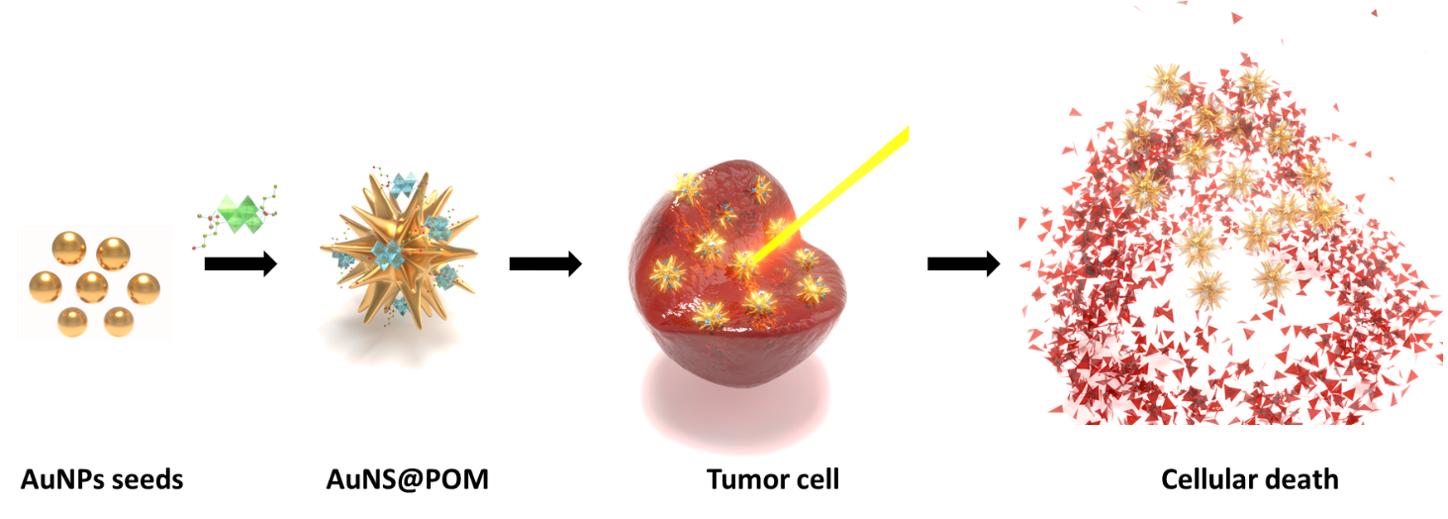Polyoxometalate-Stabilized Gold Nanostars for combined chemo/photothermal cancer therapy
J.F. Ramirez Henao1,3, S. Boujday1, C. Wilhelm2, P. Mialane 3, A. Dolbecq3, A. Vallée1
1Laboratoire de Réactivité de Surface (LRS), UMR CNRS 7197,Sorbonne Université, Paris, France
2Laboratoire Physico Chimie Curie (PCC), UMR168, CNRS & Institut Curie,Paris, France
3Institut Lavoisier de Versailles, UVSQ, UMR CNRS 8180, Université Paris-Saclay, Versailles, France
Despite the evolution of tumor treatments, current cancer treatments still have many defects with limited efficacity and side effects. It is therefore essential to find an alternative to current treatments.
Gold nanoparticles (AuNP) are amongst the state-of-the-art actors for biomedical applications because of their low toxicity and the possibility to consider combinatorial therapy to achieve an optimized global therapeutic effect. [1] AuNPS show excellent performances in photothermal therapy (PTT) and can be easily functionalized with therapeutic agent allowing the facilitation of cellular internalization of the active agents while limiting their quantity.
Polyoxometalates (POMs), a class of molecular oxides composed of metals in high oxidation states, typically are emerging as new antitumor agents. The synergistic effect of spherical gold nanoparticles (phototherapy) with hybrid POMs (chemotherapy) has already been studied by our group and has provided a combined antitumor activity through drug delivery and photothermal therapy. [2] However, by changing the morphology of the nanoparticles from spherical to star-shaped, the plasmon band shifts towards the near-infrared region where biological tissue is transparent, allowing for deeper irradiation with less risk of burns. [3]
In this work, gold nanostars (AuNS) were prepared for the first time using organic-inorganic hybrid POMs without the use of toxic surfactants for combined therapy applications. In this two-step synthesis (nucleation and growth), the POM not only acts as a reducing agent for the gold salt and stabilizer but also as a drug. The obtained AuNS were characterized by Uv-visible spectroscopy, electron microscopy, ICP, and DLS and then tested in vitro on U87 and MCF7 tumor cells with and without laser irradiation.

Reference
[1] Beik, J.; Khateri, M.; Khosravi, Z.; Kamrava, S. K.; Kooranifar, S.; Ghaznavi, H.; Shakeri-Zadeh, Coord. Chem. Rev.,2016,387
[2] S. Tomane, C. Wilhelm, S. Boujday, A. Fromain, A. Miche, F. Bourdreux, A. Dolbecq, P. Mialane, A. Vallée, ACS Appl.Nano Mater. 2021, 4, 2339
[3] J. E.Ortiz-Castillo, R. C. Gallo-Villanueva,M. J. Madou, V. H. Perez-Gonzalez,Coord. Chem. Rev.,2020,425,213489

